Creating a timeline project isn't just about linearly arranging tasks and deadlines. It's about crafting a visual narrative of your project journey, a narrative that can be as creative as it is practical. Whether you're managing a small team project or orchestrating a large-scale operation, injecting creativity into your timeline can make the planning process more engaging and effective. In this article, Let's explore ways to unleash creativity in timeline projects for effective planning.

What is a creative timeline?
A creative timeline is a visual representation of the chronological order of events or milestones in a creative project or process. It helps to track and manage the progress of different stages or tasks, ensuring that the project stays on schedule and all necessary steps are completed. A creative timeline typically includes key dates, deadlines, deliverables, and dependencies, allowing team members to understand the overall timeline and their responsibilities. It can be a useful tool for planning, organizing, and coordinating the various aspects of a creative project, such as content creation, design, development, and implementation.

A timeline is a visual tool used to display events, activities, or processes in chronological order on a time axis. It can depict the sequence of historical development or the progress of a plan or project. The so-called "creative timeline" adds more elements to the traditional timeline, such as unique graphic design, color matching, pictures or animations, etc., making it more attractive and interesting.
1. Design Eye-catching Nodes
Each event or activity on the creative timeline can be considered as a node. The design of these nodes is crucial and can use different shapes, colors, or icons to represent different types of events. At the same time, each node can also carry more detailed information such as text descriptions pictures videos, etc.
2. Innovate Ways to Display The Timeline
Traditional timelines are often straight lines but in creative timelines this rule could be broken by trying various interesting display methods for instance using spiral waveforms tree diagrams etc., to present timelines offering audiences brand-new visual experiences.
3. Add Interactive Elements
If your timeline is displayed on a webpage or application you could add various interactive elements to enhance user experience for example users could explore contents on the timeline by clicking sliding zooming etc., and tooltip pop-ups could also be set up to display more detailed information when users hover over certain nodes.
4. Unify and Carefully Design Themes
When designing creative timelines one should maintain overall style consistency including color-matching font selection icon style etc., moreover, themes corresponding with content like technology history travel, etc. could be chosen enhancing timelines' attractiveness.
Creative timelines not only help present information clearly plus intuitively but also stimulate audiences' interest plus participation through creative designs therefore whether in education business daily life, creative timelines have wide applications.
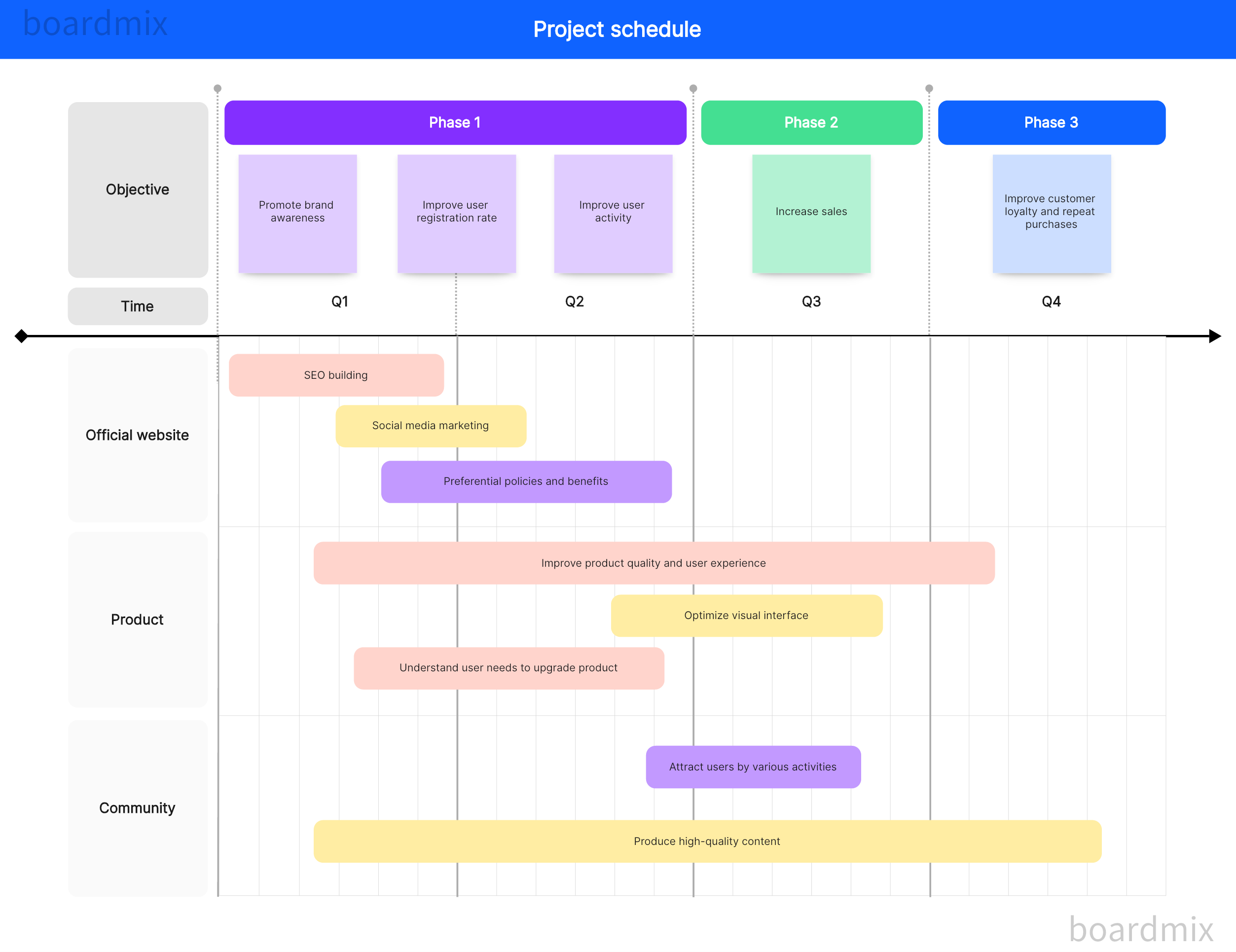
Why Visual Planning is Important for a Project?
Visual planning, while it may seem like a simple concept, can be a linchpin in your project management strategy. It's akin to having a map in hand, guiding you through the terrain of tasks, deadlines, and resources. Visual planning is important for a project for several reasons.
- Clear communication: Visual planning allows team members to clearly understand the project's goals, timeline, and tasks. It visually represents the project's progress and helps everyone involved stay on the same page.
- Easy tracking: Visual planning makes it easy to track the progress of tasks and milestones. Team members can visually see which tasks are completed, in progress, or still pending, making it easier to manage and prioritize work.
- Identifying dependencies: Visual planning helps identify dependencies between tasks. Team members can see which tasks need to be completed before others can start, ensuring that the project moves forward smoothly without delays.
- Resource allocation: Visual planning allows for effective resource allocation. Team members can see which tasks require specific skills or resources and allocate them accordingly, ensuring that the right people are assigned to the right tasks at the right time.
- Flexibility: Visual planning provides a flexible project management framework. It allows for adjustments and changes to be made easily, accommodating unforeseen circumstances or changes in priorities.
- Collaboration: Visual planning facilitates collaboration among team members. It provides a shared understanding of the project and allows team members to contribute their ideas, insights, and feedback.
Overall, visual planning is important for a project as it enhances communication, tracking, dependency management, resource allocation, flexibility, and collaboration. It ensures that the project stays on track, meets deadlines, and achieves its goals effectively and efficiently.

What Should a Good Timeline Project Include?
A good timeline project, much like a well-charted roadmap, can be instrumental in steering your project to success. It's more than just a chronological list of tasks; it's a visual representation of your project journey, highlighting key milestones, deadlines, and dependencies. But what elements should it include to be truly effective? Here are some main components.

- Clear milestones: A good timeline project should have clear milestones or checkpoints that indicate important events or deadlines throughout the project. These milestones help track progress and ensure that the project stays on schedule.
- Specific tasks: Each milestone on the timeline should be broken down into specific tasks that need to be completed. These tasks should be detailed enough to provide a clear understanding of what needs to be done.
- Dependencies: The timeline should indicate any dependencies between tasks. This means identifying which tasks need to be completed before others can start. Understanding dependencies helps prevent delays and ensures smooth progress.
- Duration: The timeline should include an estimated duration for each task or milestone. This helps with scheduling and resource allocation, as it provides an idea of how long each task will take to complete.
- Assignees: It is important to assign specific team members or individuals to each task or milestone. This helps clarify responsibilities and ensures that everyone knows what they need to do.
- Visual representation: A good timeline project should be visually appealing and easy to understand. It should be presented in a clear and organized format, such as a Gantt chart or a visual timeline tool.
- Regular updates: The timeline should be regularly updated to reflect any changes or updates to the project. This helps everyone involved stay informed and ensures that the timeline remains accurate.
Overall, a good timeline project includes clear milestones, specific tasks, dependencies, duration estimates, assignees, a visual representation, and regular updates. By incorporating these elements, a timeline project becomes a valuable tool for planning, tracking, and managing the progress of a project.
How to Do a Timeline for a Project?
A project timeline is an important tool in project management to visualize the major phases, tasks, milestones, and estimated completion time of a project. Here are the steps on how to make a timeline for a project.
1. Identify the key phases and tasks of the project
First, the key phases of the project and the specific tasks for each phase need to be identified. This can be done through discussion with the project team, by referring to previous experience with similar projects, or by using a project management methodology (e.g. WBS - Work Breakdown Structure).
2. Set the timing and sequence of tasks
For each task, determine its expected start and finish dates, taking care to consider dependencies between tasks, such as which tasks need to be performed serially and which can be performed in parallel.
3. Mark project milestones
Milestones are important points in the project, such as key decisions, completion of major deliverables, and so on. Marking these milestones on the timeline can help the team focus on key progress.
4. Create timeline charts
A timeline chart is created using a tool such as Microsoft Project, or Excel, or an online project management tool such as Trello. The chart should clearly show where each phase, task, and milestone is on the timeline.
5. Share and update the project timeline
Once created, the project timeline should be shared with all relevant people and updated regularly during the project. Any changes (e.g., progress of tasks, new tasks, or changes) should be reflected in the timeline promptly.
In short, creating a clear and accurate project timeline can effectively help the project team understand and track the project's progress, and improve the management efficiency of the project.
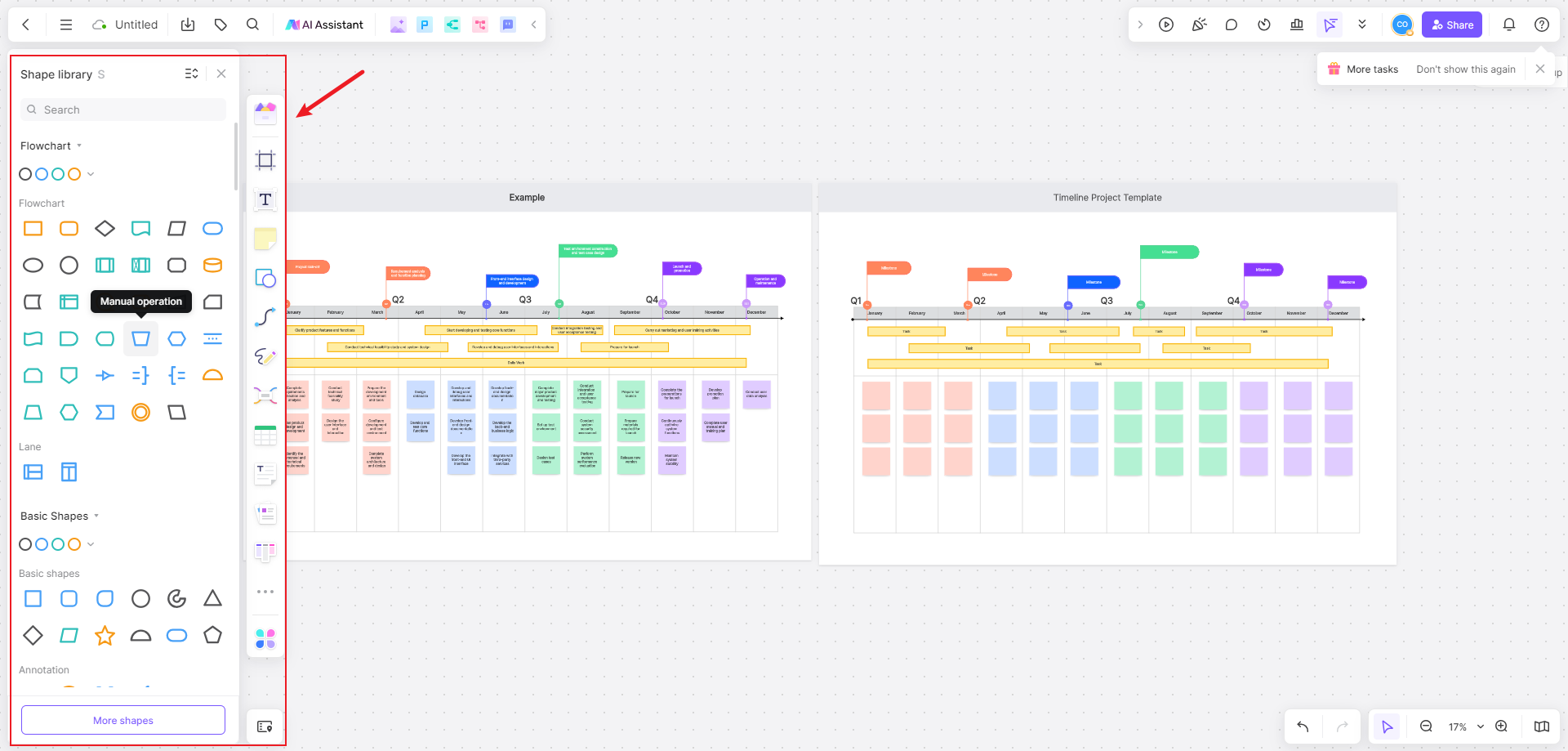
8 Timeline Project Ideas for Practical Planning
Timelines are a powerful planning and visualization tool, whether you're planning a new business project or want to see how historical events are trending. Here are 8 practical timeline project ideas that can be used for effective planning.
1. Product Development Timeline
Product development is a complex process that involves multiple stages such as conceptualization, prototyping, testing, production, and marketing. Creating a product development timeline can help you clarify the timing of each phase, as well as mark key milestones.
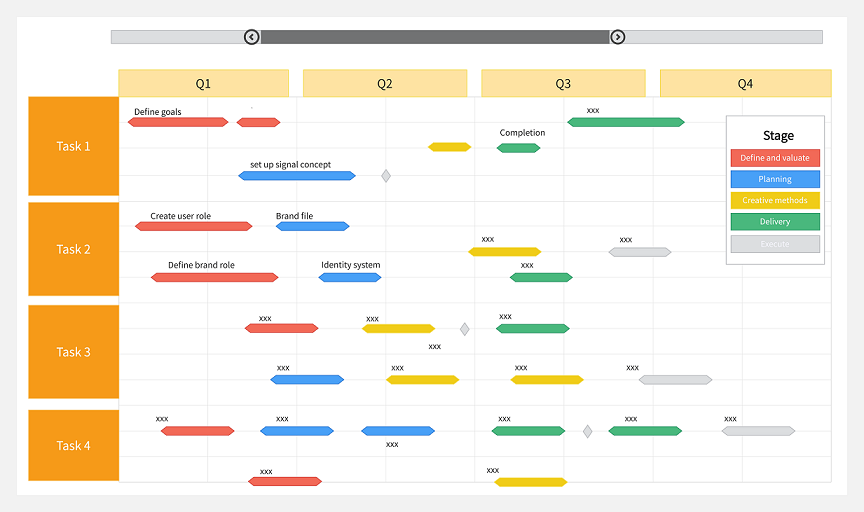
2. Corporate Strategic Planning Timeline
Corporate strategic planning requires a clear view of how your business will evolve over the next few years. A timeline can help you list out key business goals and activities and assign specific time frames to each activity.
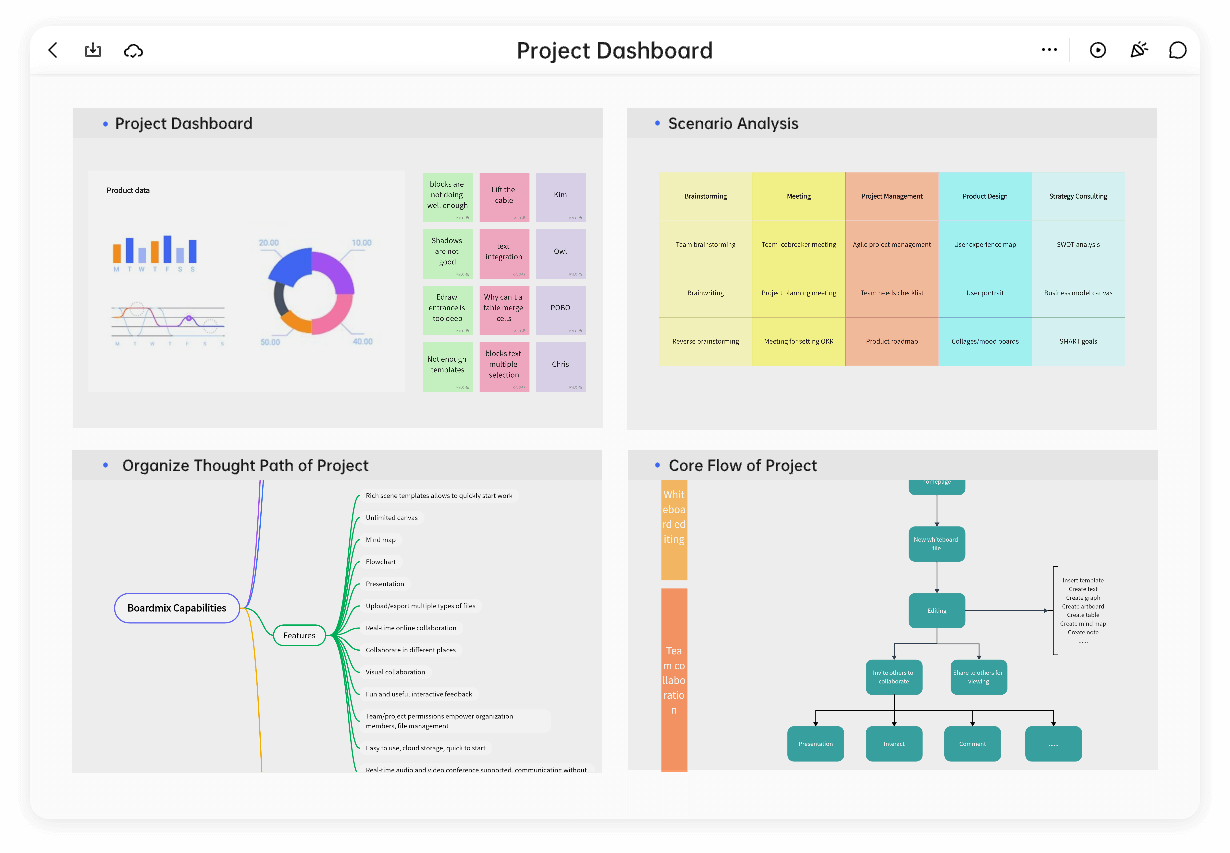
3. Personal Growth or Career Planning Timeline
You can use a timeline to plan your personal growth or career development. This timeline can include the key skills, certifications, or positions you hope to achieve, as well as the estimated time needed to complete each stage.

4. Educational or Research Program Timeline
Educational or research projects often have strict time constraints. Creating a detailed timeline with dates for all research tasks, reports, and exams can help you manage your time better.
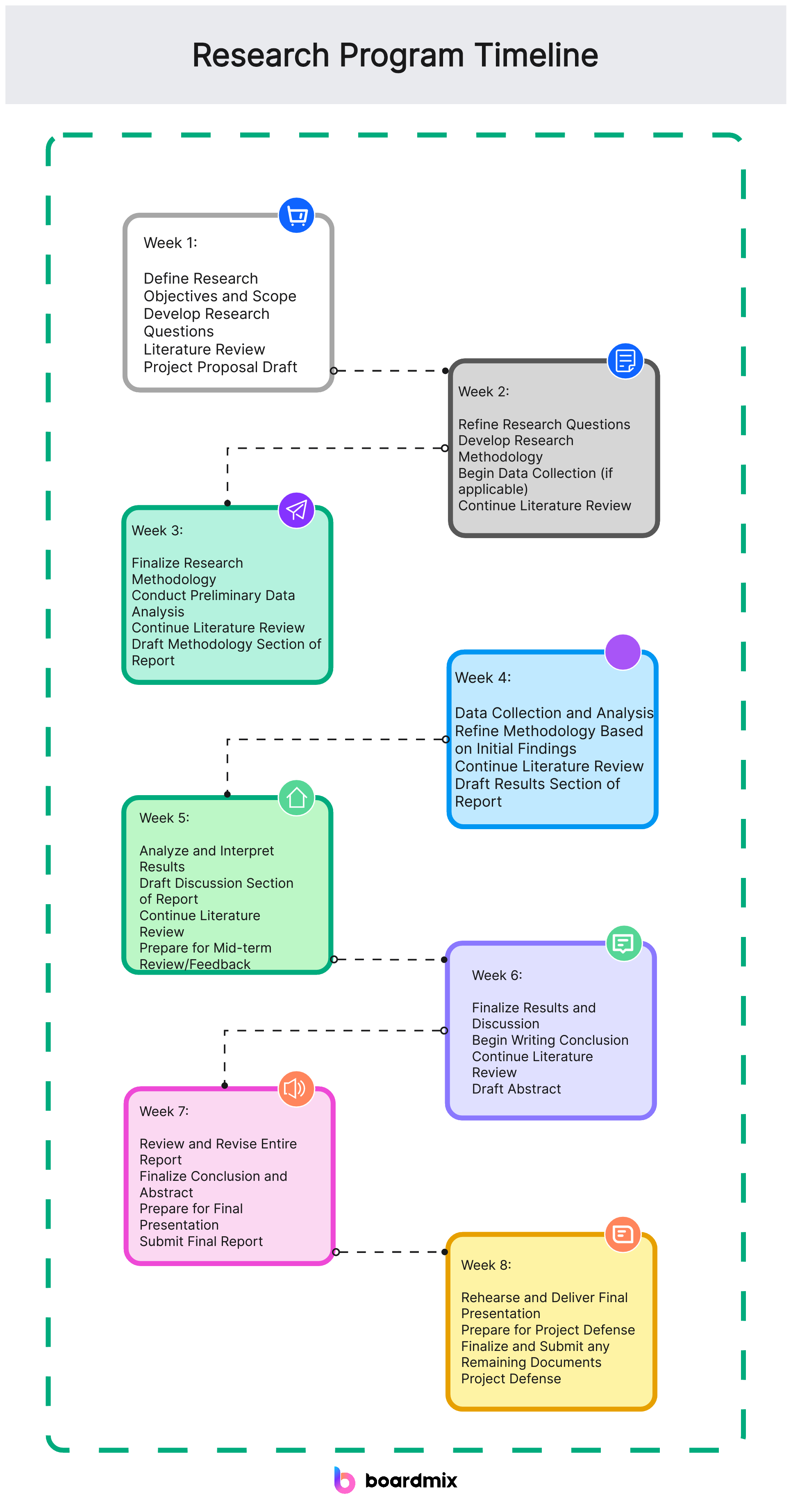
5. Historical Events Study Timeline
For studying historical events or cultural studies, creating a detailed timeline can help you better understand and remember how events develop and change.
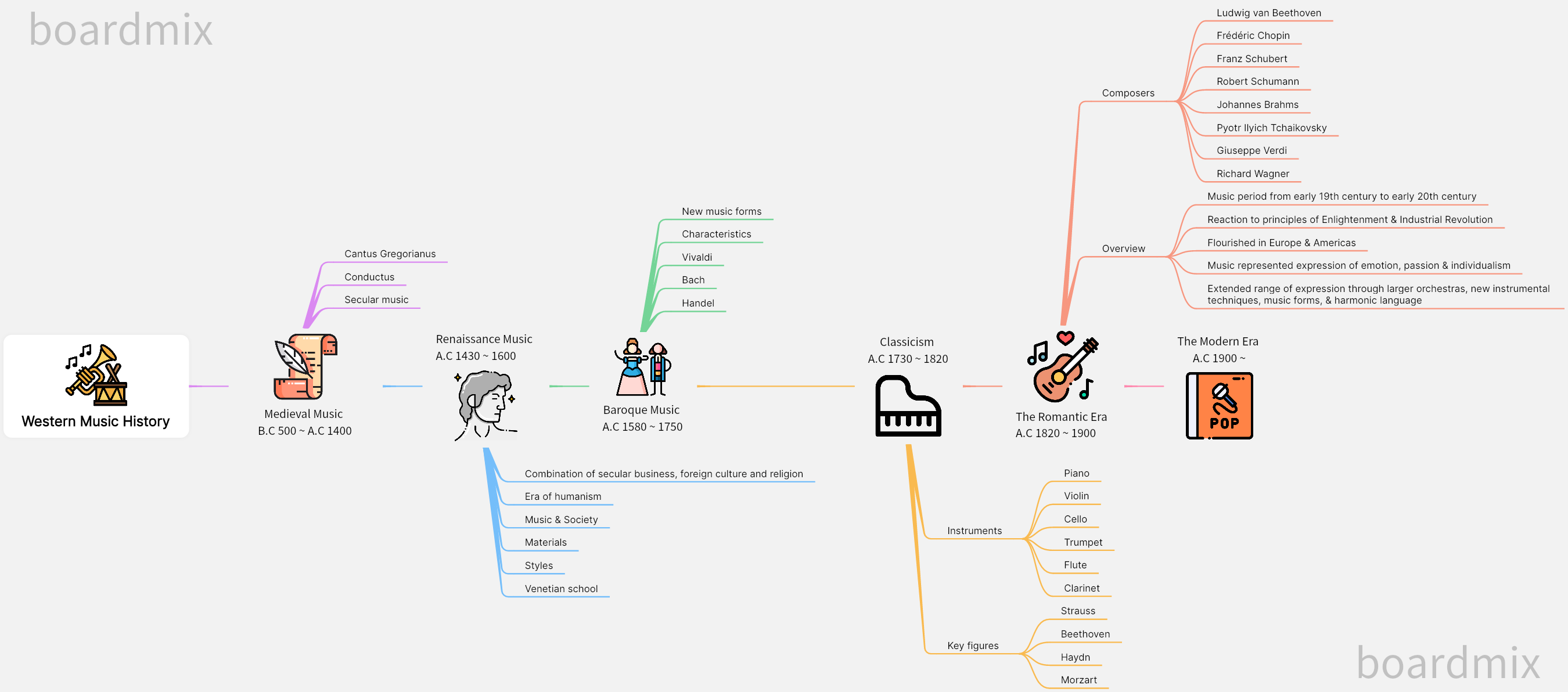
6. Home renovation timeline
Create a timeline for a home renovation project, outlining key milestones such as obtaining permits, completing demolition, selecting materials, and finishing each room. Include specific tasks and assignees to ensure a smooth and organized renovation process.
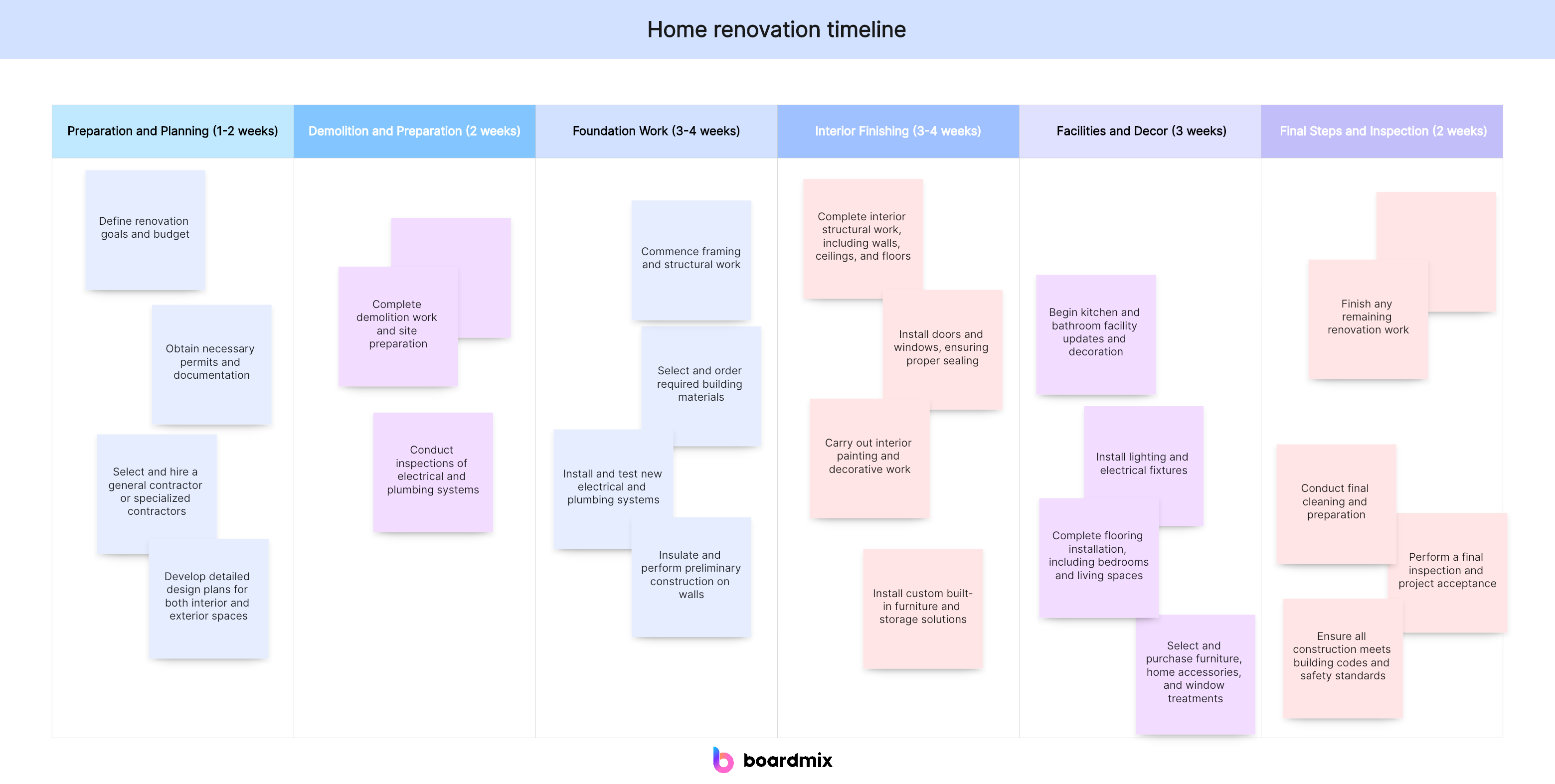
7. Event planning timeline
Develop a timeline for planning an event, including tasks such as venue selection, budgeting, sending invitations, arranging catering, and organizing entertainment. Add dependencies to ensure tasks are completed in the correct order and assign team members to each task.
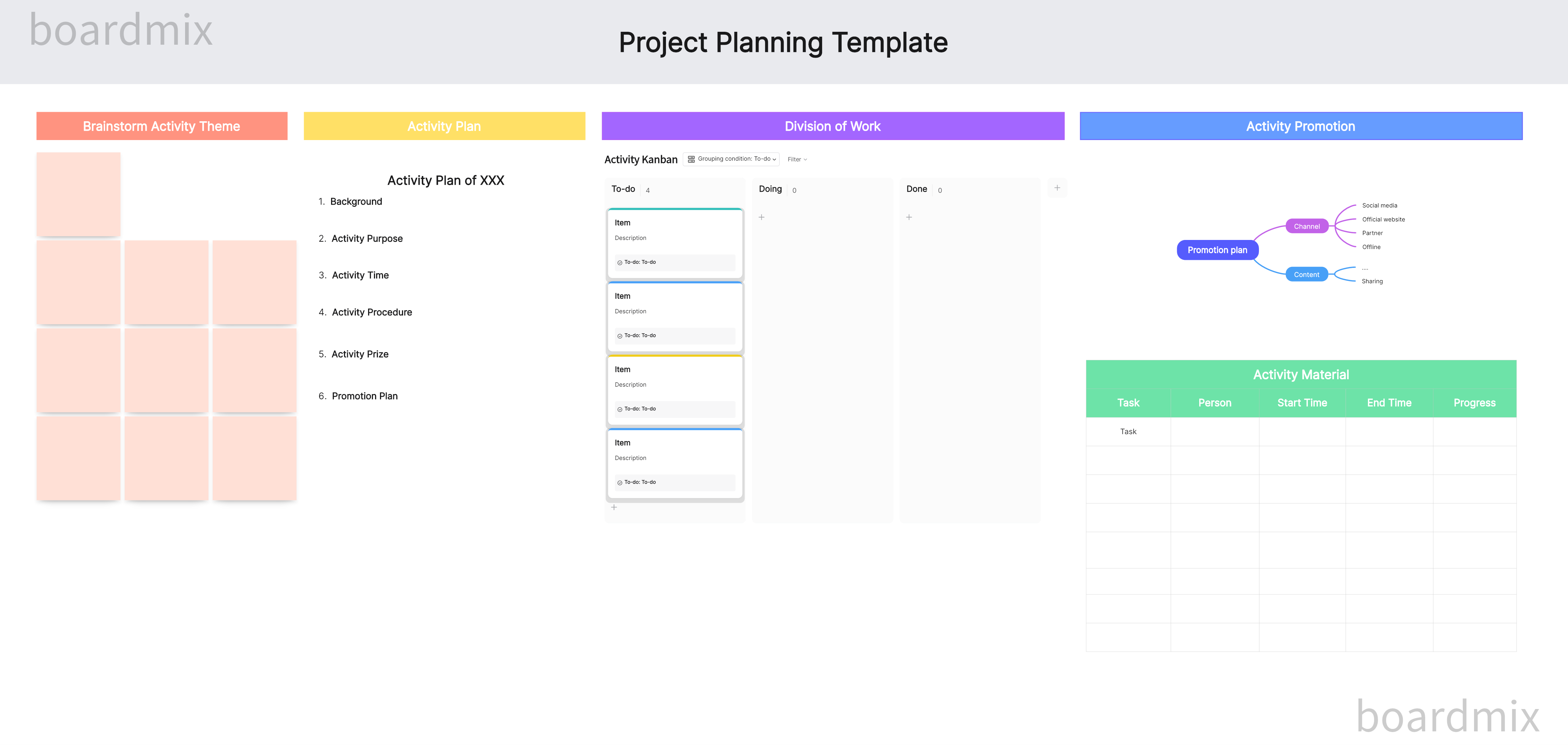
8. Marketing campaign timeline
Develop a timeline for a marketing campaign, outlining tasks such as market analysis, content creation, social media promotion, email marketing, and performance tracking. Set deadlines for each task and assign team members to ensure timely execution.
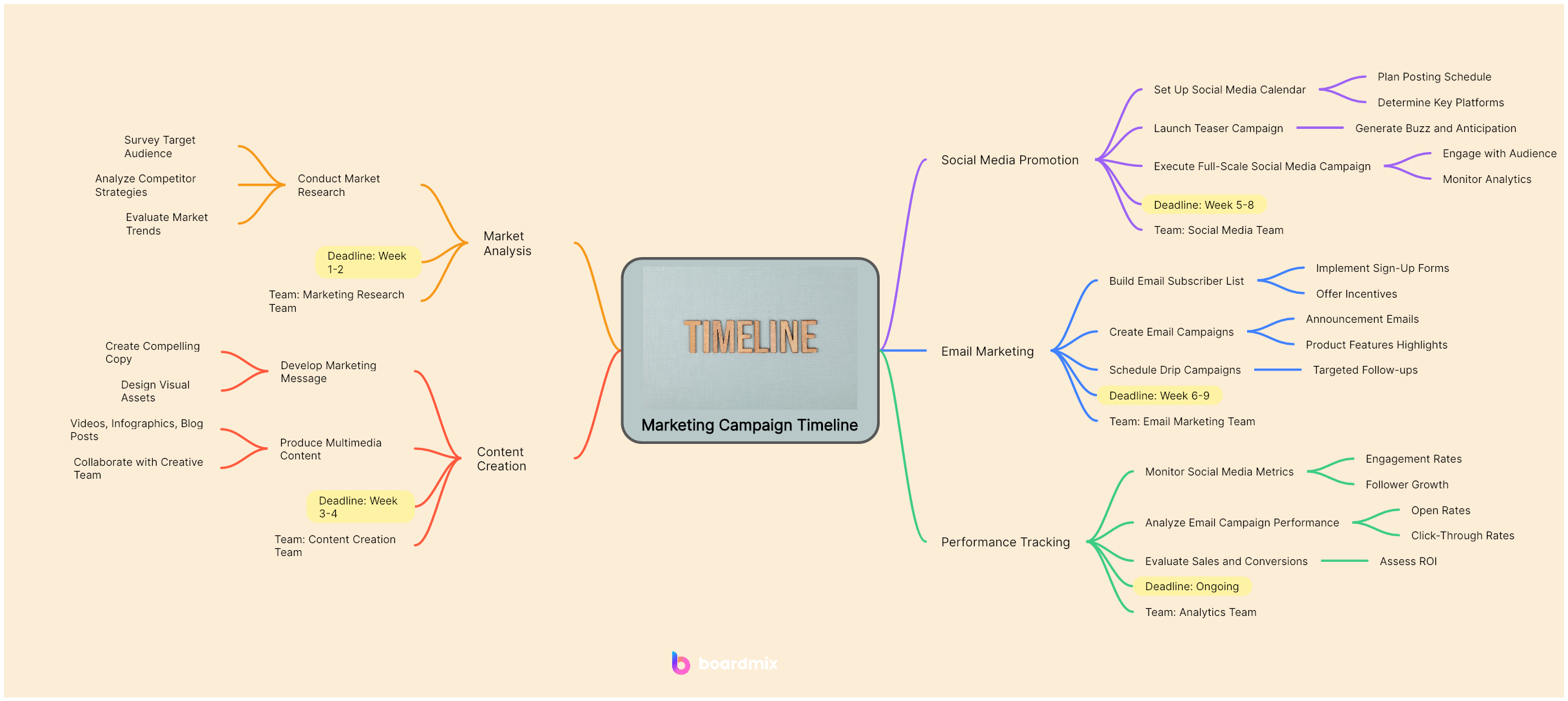
Planning a project with a timeline can provide a clear visual representation, help keep track of project progress, and ensure that all tasks are on schedule. Remember to customize each timeline project according to your specific needs and goals. A well-planned timeline will help you stay organized, meet deadlines, and achieve successful outcomes.
Conclusion
In summary, exploring creative timelines enhances the project planning process by fostering innovation and efficiency. As a powerful and user-friendly online collaborative teamwork tool, Boardmix stands out as an ideal platform for crafting engaging timeline projects. Its intuitive interface and collaborative features make it easy for teams to brainstorm, plan, and execute projects seamlessly. Boardmix's versatility aligns perfectly with the dynamic nature of timeline projects, allowing teams to unleash their creativity while maintaining a structured and organized workflow.
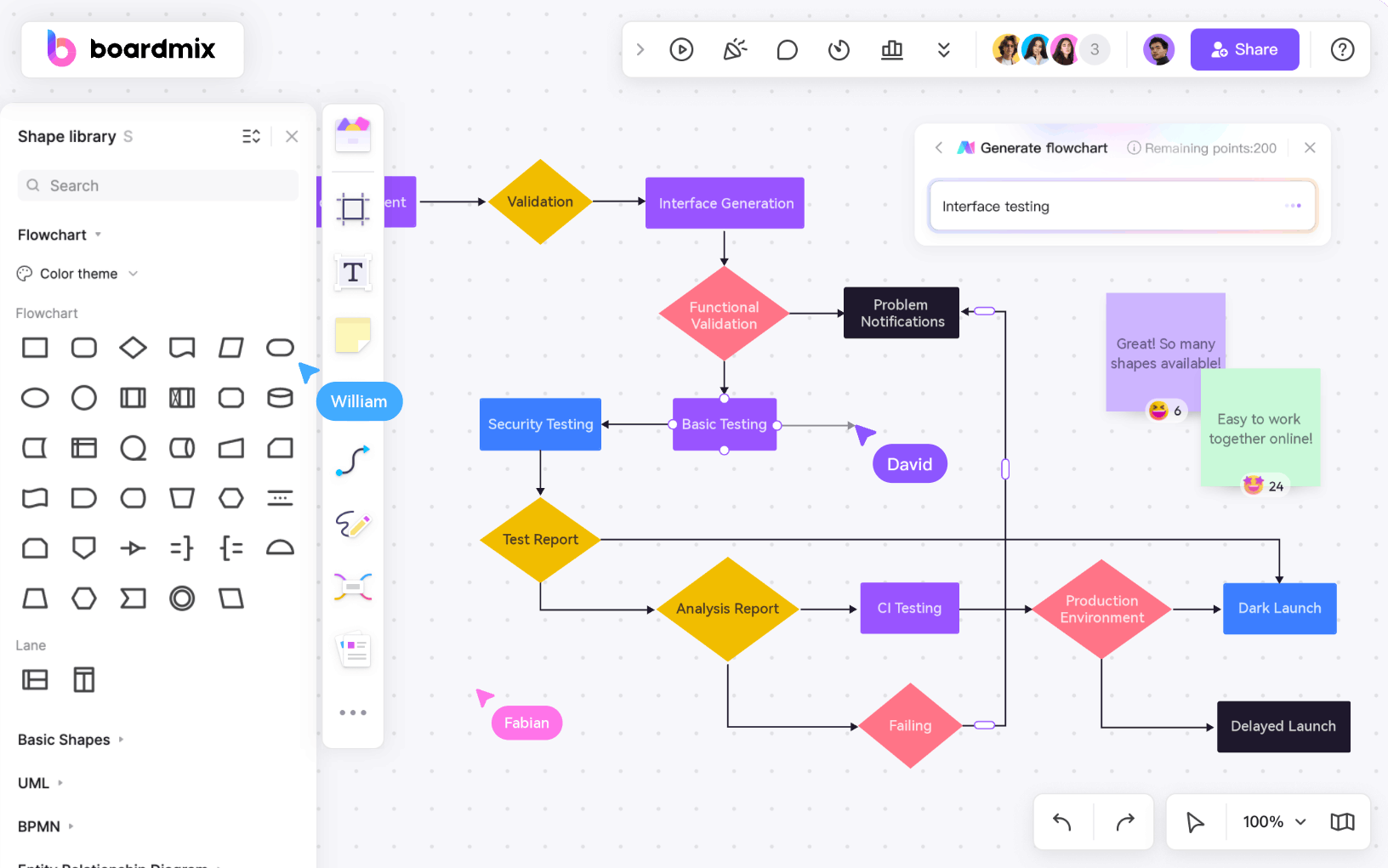
For those wondering how to create a timeline for a project, the process involves meticulous planning, attention to detail, and the utilization of user-friendly tools. One such remarkable tool is Boardmix, an online collaborative teamwork platform that excels in crafting compelling timeline projects. For effective and practical timeline project ideas, leverage the collaborative capabilities of Boardmix. Take the next step in elevating your project planning experience by utilizing Boardmix's innovative features. Start today and transform your timelines into dynamic, visually appealing, and successful projects.








